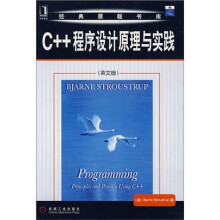Preface
Chapter 0 Notes to the Reader
0.1 The structure of this book
0.1.1 General approach
0.1.2 Drills, exercises, etc.
0.1.3 What comes after this book?
0.2 A philosophy of teaching and learning
0.2.1 The order of topics
0.2.2 Programming and programming language
0.2.3 Portability
0.3 Programming and computer science
0.4 Creativity and problem solving
0.5 Request for feedback
0.6 References
0.7 Biographies
Bjarne Stroustrup
Lawrence "Pete" Pcterscn
Chapter 1 Computers, People, and Programming
1.1 introduction
1.2 Software
1.3 People
1.4 Computer science
1.5 Computers are everywhere
1.5.1 Screens and no screens
1.5.2 Shipping
1.5.3 Telecommunications
1.5.4 Medicine
1.5.5 Information
1.5.6 A verdcal view
1.5.7 So what?
1.6 I deals for programmers
Part Ⅰ The Basics
Chapter 2 Hello, World!
2.1 Programs
2.2 The dassic first program
2.3 Compilation
2.4 Linking
2.5 Programming environments
Chapter 3 Objects, Types, and Values
3.1 Input
3.2 Variables
3.3 Input and type
3.4 Operations and operators
3.5 Assignment and initialization
3.5.1 An example: detect repeated words
3.6 Composite assignment operators
3.6.1 An example: find repeated words
3.7 Names
3.8 Types and objects
3.9 Type safety
3.9.1 Safe conversions
3.9.2 Unsafe conversions
Chapter 4 Computation
4.1 Computation
4.2 Objectives and tools
4.3 Expressions
4.3.1 Constant expressions
4.3.2 Operators
4.3.3 Conversions
4.4 Statements
4.4.1 Selection
4.4.2 Iteration
4.5 Functions
4.5.1 Why bother with functions?
4.5.2 Function declarations
4.6 Vector
4.6.1 Growing a vector
4.6.2 A numeric example
4.6.3 A text example
4.7 Language features
Chapter 5 Errors
5.1 Introduction
5.2 Sources of errors
5.3 Compile-time errors
5.3.1 Syntax errors
5.3.2 Type errors
5.3.3 Non-errors
5.4Link-time errors
5.5Run-time errors
5.5.1 The caller deals with errors
5.5.2 The callee deals with errors
5.5.3 Error reporting
5.6 Exceptions
5.6.1 Bad arguments
5.6.2 Range errors
5.6.3 Bad input
5.6.4 Narrowing errors
5.7 Logic errors
5.8 Estimation
5.9 Debugging
5.9.1 Practical debug advice
5.10 Pre-and post-conditions
5.10.1 Post-conditions
5.11 Testing
Chapter 6 Writing a Program
6.1 A problem
6.2 Thinking about the problem
6.2.1 Stages of development
6.2.2 Strategy
6.3 Back to the calculator!
6.3.1 First attempt
6.3.2 Tokens
6.3.3 Implementing tokens
6.3.4 Using tokens
6.3.5 Back to the drawing board
6.4 Grammars
6.4.1 A detour: English grammar
6.4.2 Writing a grammar
6.5 Turning a grammar into code
6.5.1 Implementing grammar rules
6.5.2 Expressions
6.5.3 Terms
6.5.4 Primary expressions
6.6 Trying the first version
6.7 Trying the second version
6.8 Token streams
6.8.1 Implementing Token_stream
6.8.2 Reading tokens
6.8.3 Reading numbers
6.9 Program structure
Chapter 7 Completing a Program
7.1 Introduction
7.2 Input and output
7.3 Error handling
7.4 Negative numbers
7.5 Remainder: %
7.6 Cleaning up the code
7.6.1 Symbolic constants
7.6.2 Use of functions
7.6.3 Gode layout
7.6.4 Commenting
7.7 Recovering from errors
7.8 Variables
7.8.1 Variables and definitions
7.8.2 Introducing names
7.8.3 Predefined names
7.8.4 Are we there yet?
……
Part Ⅱ Input and Output
Part Ⅲ Data and Algorithms
Part Ⅳ Broadening the View
Part Ⅴ Appendices
Glossary
Bibliography
Index

 缺书网
缺书网 扫码进群
扫码进群





